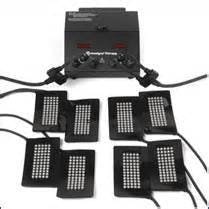
Anodyne therapy is a type of light therapy that is used to help relieve the symptoms of pain, stiffness, muscle spasms, and circulation irregularities. This form of treatment is usually given in addition to physical therapy. It works by relieving pain and/or increasing circulation in the area where the patient is experiencing pain. The scientific term for Anodyne therapy is monochromatic infrared photo energy (MIRE).
All forms of Anodyne therapy use infrared light. Pads that emit the light are applied to the surface of the skin. At times, Anodyne therapy will resolve symptoms in one or only a few sessions. For other individuals, however, ongoing Anodyne therapy may be necessary to experience relief from symptoms. Anodyne therapy may help a patient cope with the symptoms of their medical condition because the pain relief and increased circulation provided by the near infrared light may aid in improving a patient's balance, range of motion, endurance, strength, and flexibility.
The mechanism of action underlying pain relief associated with Anodyne Therapy/MIRE may be due, in part, to a combination of topical heat and an increased local release of nitric oxide that has been reported using this wavelength (890nm) of near infrared light energy. The source of released nitric oxide may be endothelial cells or red blood cells, or both.
Nitric oxide has been studied for many years; however, interest has peaked in the last 10-15 years as a result of the discovery of the role of nitric oxide as a signaling mechanism in the human body. The researchers of this discovery were awarded the Nobel Prize in Physiology in 1998.
Eleven clinical trials have been conducted to evaluate the efficacy of Anodyne therapy for several different medical conditions. Though the results of these studies appear promising, larger studies need to be conducted before a firm conclusion can be drawn. These clinical studies have been published in such journals as Diabetes Care, Practical Pain Management, Age and Ageing and Endocrine Practice.
As a relatively inexpensive treatment, Anodyne therapy is gaining popularity in the United States. Most health insurances reimburse patients for near MIRE.
